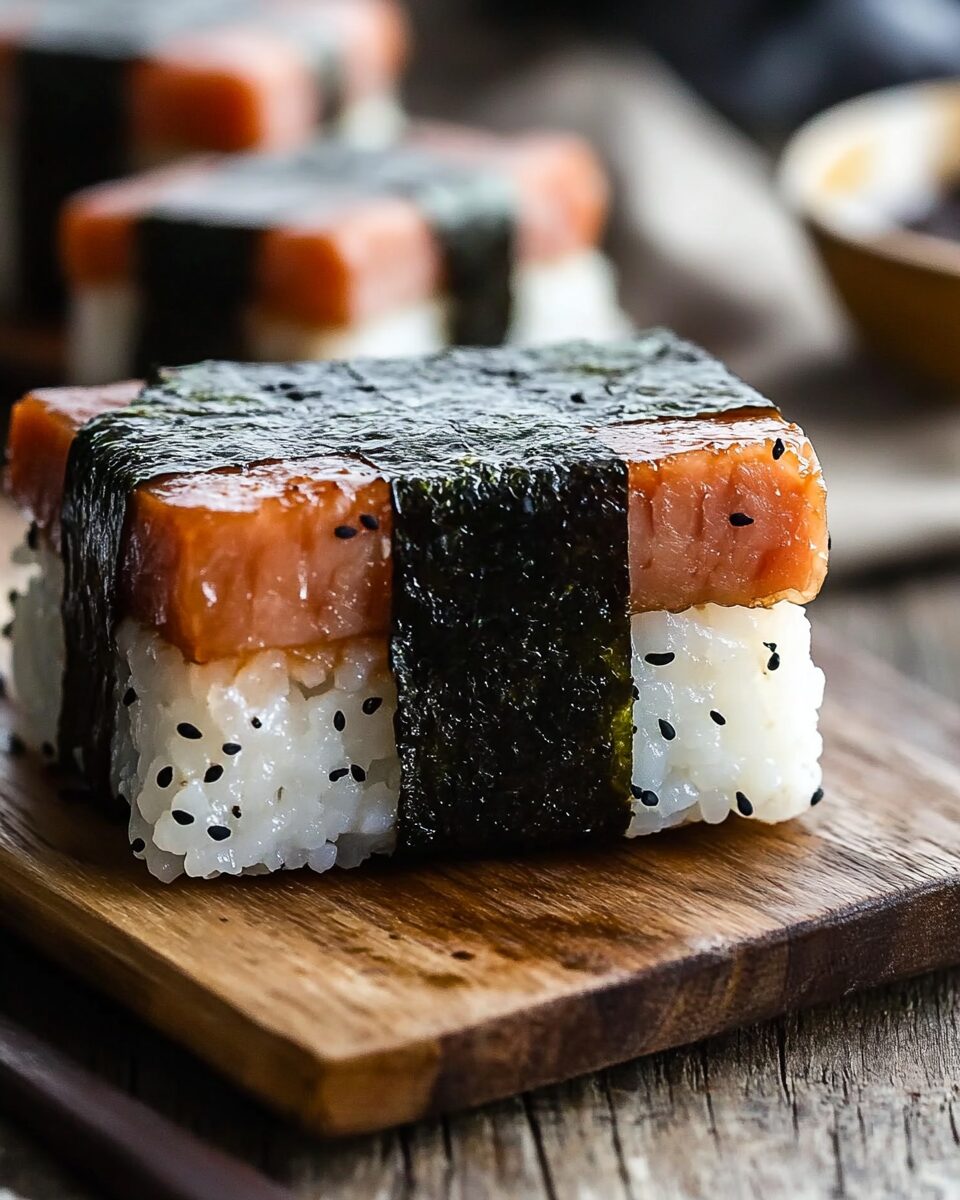Spam Musubi is a popular Hawaiian snack that combines savory grilled Spam with seasoned sushi rice, all wrapped in a crisp sheet of nori seaweed. This delightful fusion offers a unique taste experience, making it a favorite among many.
FULL RECIPE:
Ingredients
- 2 cups sushi rice
- 2 cups water
- 1/4 cup rice vinegar
- 2 tablespoons sugar
- 1 teaspoon salt
- 1 can Spam
- 1/4 cup soy sauce
- 1/4 cup oyster sauce
- 1/4 cup sugar
- 5 sheets nori (seaweed)
Directions
- Cook the Rice: Rinse the sushi rice under cold water until the water runs clear. Combine the rice and 2 cups of water in a rice cooker and cook according to the manufacturer’s instructions.
- Season the Rice: In a small saucepan, heat the rice vinegar, 2 tablespoons sugar, and salt over medium heat until dissolved. Once the rice is cooked, transfer it to a large bowl and gently fold in the vinegar mixture. Allow the rice to cool slightly.
- Prepare the Spam: Remove the Spam from its can and slice it into 10 equal pieces. In a bowl, mix the soy sauce, oyster sauce, and 1/4 cup sugar until the sugar dissolves.
- Cook the Spam: Heat a large skillet over medium-high heat. Add the Spam slices and cook until both sides are lightly browned. Pour the soy sauce mixture over the Spam and continue to cook, turning occasionally, until the liquid has reduced and the Spam is caramelized. Remove from heat.
- Assemble the Musubi: Cut each nori sheet in half lengthwise. Place a strip of nori, shiny side down, on a clean surface. Place the musubi mold on the center of the nori. Add about 1/2 cup of seasoned rice into the mold, pressing it down firmly. Place a slice of the cooked Spam on top of the rice and press down again. Remove the mold. Wrap the nori around the rice and Spam, sealing the edge with a bit of water. Repeat with the remaining ingredients.
- Serve: Let the musubi sit for a few minutes to allow the nori to soften slightly before serving. Enjoy warm or at room temperature.
Nutrition Facts
- Serving Size: 1 piece
- Calories: 250
- Total Fat: 10g
- Saturated Fat: 3.5g
- Cholesterol: 40mg
- Sodium: 800mg
- Total Carbohydrates: 30g
- Dietary Fiber: 1g
- Sugars: 10g
- Protein: 10g
History and Cultural Significance
The history of Spam Musubi dates back to World War II when Spam was introduced to Hawaii by American soldiers. Due to its long shelf life and affordability, Spam quickly became a staple in Hawaiian households. Inspired by Japanese onigiri, a traditional rice ball wrapped in seaweed, Spam Musubi was born as a creative adaptation using available ingredients. Today, it remains a symbol of the islands’ multicultural culinary heritage. Spam Musubi is often associated with the concept of “local grindz,” which refers to the comforting and casual foods enjoyed by locals. It’s a common sight at beaches, picnics, and school lunchboxes, reflecting its status as a convenient and satisfying snack. Many families have their own variations, adding eggs, furikake, or teriyaki sauce to personalize the flavor. Despite its simplicity, Spam Musubi is a cherished part of Hawaiian culture.
Nutritional Information and Health Considerations
While Spam Musubi is undeniably delicious, it is important to consider its nutritional content. Spam, a processed meat product, is relatively high in sodium and fat. Each serving typically contains around 250 calories, with about 10 grams of fat, 40 milligrams of cholesterol, and 800 milligrams of sodium. The combination of white rice and Spam provides carbohydrates and protein, but it may lack dietary fiber and other essential nutrients. For those seeking a healthier alternative, there are several modifications that can be made. Using brown rice or cauliflower rice can increase fiber content and reduce calorie intake. Additionally, low-sodium Spam or homemade grilled pork slices can lower the sodium levels. Swapping out traditional soy sauce for a reduced-sodium version also makes a noticeable difference. Including fresh vegetables like cucumber or avocado adds nutritional value while enhancing the overall flavor. With mindful adjustments, Spam Musubi can be a balanced part of a well-rounded diet.
Serving Suggestions and Pairings
Spam Musubi is incredibly versatile and pairs well with a variety of side dishes and beverages. It is often served with traditional Hawaiian sides like macaroni salad, coleslaw, or a simple cucumber salad. For a complete meal, it can be paired with miso soup, edamame, or seaweed salad. The sweet and savory notes of the musubi also complement tropical fruits like pineapple or mango, making it a refreshing combination. For those hosting a gathering, Spam Musubi can be presented as a part of a Hawaiian-themed spread. Adding a selection of poke bowls, grilled teriyaki chicken, and fresh fruit platters enhances the dining experience. Beverages such as pineapple juice, iced tea, or coconut water pair nicely, offering a refreshing contrast to the savory Spam Musubi.
Tips for Perfect Spam Musubi
Achieving the perfect Spam Musubi requires attention to detail, especially when it comes to the rice. The rice should be slightly sticky, ensuring it holds its shape without falling apart. Using a rice paddle and wetting your hands with water helps prevent sticking during the assembly process. Pressing the rice firmly into the musubi mold ensures a uniform shape and texture. Caramelizing the Spam properly is another crucial step. Cooking the Spam in a mixture of soy sauce, sugar, and oyster sauce creates a glossy, flavorful coating. Ensuring both sides are evenly browned adds a deliciously savory crust. Wrapping the musubi with nori should be done swiftly to prevent the seaweed from becoming too brittle.
Conclusion
Spam Musubi is more than just a snack; it is a reflection of Hawaii’s diverse cultural influences and culinary ingenuity. With its balance of savory, sweet, and umami flavors, it offers a comforting taste that resonates with both locals and visitors alike. Whether enjoyed as a quick lunch, picnic treat, or party appetizer, Spam Musubi is a delicious testament to the resourcefulness and creativity of Hawaiian cuisine. By making simple adjustments, it can be adapted to fit various dietary preferences, ensuring everyone can savor this iconic dish. For those looking to experience a true taste of Hawaii, Spam Musubi is a perfect place to start. Its nostalgic charm and irresistible flavor make it a recipe worth adding to your collection.






